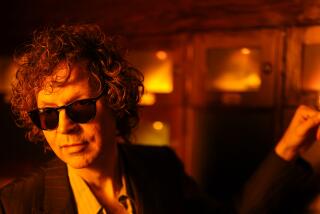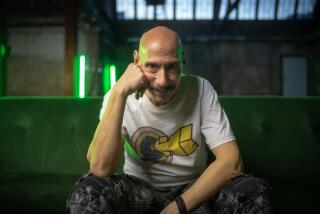Secret Formula
The searing dance single “Chemical Beats” starts off with an ominous, alarming loop before it’s overtaken by a hard-edged guitar riff--the type that Beavis & Butt-head might emulate with their air-instrumental enthusiasm. The song continues to build, adding a funky cowbell and relentless bass. And then there’s a simple sample: “Uh,” it says, over and over. “Uh.”
Throw your fists in the air and bow your long hair. With this 12-inch single in 1994, the Chemical Brothers, a young duo from Manchester, England, firmly established that dance music can actually rock--hard. Though others have tried to prove this point, from Afrika Bambaataa and Run-DMC to MC 900 Ft. Jesus and God Lives Underwater, the Chemicals have driven it home--and to America--with 1995’s critically acclaimed crossover “Exit Planet Dust” and with the current dance-core EP “Loops of Fury.”
With “Exit,” which includes the bombastic “Chemical Beats,” the Chemicals created a new formula for techno-meets-rock and proved they were more than a formula band, producing songs with more traditional pop structure, organic instruments and even human vocals (from the likes of Tim Burgess from the Charlatans, who sings the KROQ-friendly “Life Is Sweet”).
But “Loops of Fury” takes this duo back to its roots, pumping out layer upon layer of the maddest hip-hop beats and the heaviest guitar samples. A remix of “Chemical Beats” is all stirred up with techno funk.
And that is, after all, where these two nerdish guys come from, musically.
Tom Rowlands, the long-haired one, played the guitar in a Manchester rock band and looked up to groups such as the Jesus and Mary Chain and early rave rockers the Stone Roses. Ed Simons, the one with the short, curly hair, was a bedroom musician, programming beats and finding inspiration in old school, East Coast hip-hop.
“Hip-hop and modern rock totally coincided,” says Simons, 25, backstage at the landmark Organic ’96 dance music festival at the San Bernardino National Forrest’s Snow Valley ski resort. “Like when you were 16, you had Public Enemy and Jesus and Mary Chain. We liked all the rappers that had amazing beats: Marley Marl, Mantronix, T La Roc.”
Adds Rowlands, 26: “I liked noisy music--My Bloody Valentine.”
When it came to making their own music, they say, a unique blend of styles was only natural.
Says Rowlands, casual in sweatshirt and athletic shoes in a backstage tent as the sun sets on the outdoor Organic gathering of 6,000: “It all came together nicely.”
Rowlands is from Oxford, Simons from London. The two met while studying history at Manchester University. The school lies in the birthplace city of the modern British dance scene, home to Stone Roses, Happy Mondays and the “Madchester” acid house sound. They tried their hand at traditional bands--both playing guitar--but took to the turntables as dance music took hold at the turn of the decade. Soon they were spinning an eclectic mix of hip-hop, funk and techno in the dance clubs’ version of rock’s second stage: the back rooms.
But soon those back rooms became so packed that they became the main event. The two started tweaking their sound in a home studio and put out the self-financed “Song to the Siren” in 1994. It was a funked up jam that recalled James Brown as much as any of the hippy techno that was coming out of Manchester at the time. They admit that a parallel sound was developing in San Francisco, with Dubtribe’s eco-conscious bomb, “Mother Earth,” coming out in ’94 too. (“Both songs,” Simons says, “really broke things up in the scene.”) “Chemical Beats” soon followed and so did an album deal with Astralwerks in the United States and Virgin worldwide.
During their deejay days, the two called themselves the Dust Brothers but had to change their name after the U.S. production duo of the same name (known for its work with the Beastie Boys and, recently, Beck) protested in court--thus, “Exit Planet Dust.”
Though they were never particularly known for their turntable technique, the Chemicals are much in demand as deejays in England and even have their own club night--the Social Saturday nights in London. This night, which often features their eclectic turntable mixing (which goes from straight funk to straight rock), is celebrated in yet another recent release, “Live at the Social,” available on import from the Deconstruction label. The CD features the duo in all its turntable glory, building from rudimentary old-school beats (sampled from such figures as Eric B. & Rakim) to its own rock-ified sound.
“I mean, it surprises me that people even think it’s interesting, playing old records along with new records and hip-hop records with techno,” Rowlands says. “You can just do anything.
“It’s a great art to be able to completely change the dance floor by deejaying.”
“That’s one of the reasons we make our records,” Simons says. “That’s one of our aims is to have that impact when our record comes on the dance floor.”
Indeed, the Chemical Brothers’ sound not only rocks, but shocks. Many deejays had a hard time playing “Chemical Beats” when it first came out because it did not fit in with the continuous, thump-thump-thump house mixes they were used to playing.
“They celebrate rock, they recognize it, they have a great perspective on the roots of rock,” says L.A. radio and club deejay Jason Bentley. “But they upend it. They take a whole new song structure, the song structure of a house record, and make a psychedelic rock record.”
Indeed, they recently recorded a song called “Setting Sun,” an ode to the Beatles’ psychedelic pioneer “Tomorrow Never Knows,” with Oasis’ Noel Gallagher as the lead vocalist. The single is due out this fall, but the duo gave the crowd at Organic a sneak peek with an instrumental remix that proved to be tie-died future funk. A new album is due out this winter.
“Techno is a pretty incredible sound,” Simons says, “but there’s other ways to approach dance music.”
More to Read
The biggest entertainment stories
Get our big stories about Hollywood, film, television, music, arts, culture and more right in your inbox as soon as they publish.
You may occasionally receive promotional content from the Los Angeles Times.








